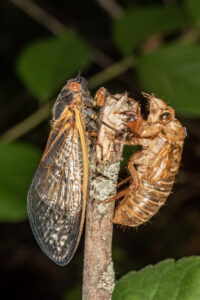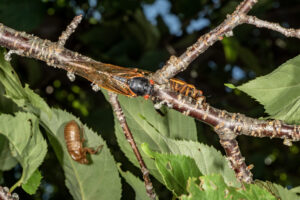Hoosiers are in for a special treat this spring. If you have lived in Indiana for more than a year, you have probably grown accustomed to the singing of cicadas in the later days of summer. However, in some years, cicadas will emerge in the spring. This occurred in 2021 when most of the state was inundated in periodical cicadas as Brood X emerged from their 17-year development. This year, two broods will emerge concurrently: Brood XIII and Brood XIX. Brood XIII is a 17-year cicada, while Brood XIX is a 13-year cicada. The emergence of these two broods isn’t unusual, but this year is special because they will emerge at the same time. Their schedules haven’t aligned for over two hundred years! The last time these two cicada songs were heard together, Thomas Jefferson was in the White House. While this may sound like Indiana is about to be covered in cicadas, there are a few facts that may change your expectations.
- Figure 1. The cicada emergence will include the 13 and 17 year broods. Photo by John Obermeyer.
There are two types of cicadas in the Midwest: annual cicadas and periodical cicadas. Annual cicadas, as the name implies, are seen each year. They normally spend two to five years underground, but there are enough of them that we see them emerge each year. Annual cicadas emerge individually, not as a group, and we see them towards the end of the summer, thus their other common name, “dog day cicadas”. Periodical cicadas have a much different life cycle. They remain in the ground as nymphs for either thirteen or seventeen years, feeding on the roots of the trees they will eventually climb. Around April, the broods will emerge together using a combination of temperature and their own internal clock. Both types of cicadas feed on deciduous trees and tend to inhabit areas where eggs were laid during previous emergences, giving them a low likelihood of moving to new areas. Annual cicadas are green with black eyes, and periodical cicadas have dark-colored bodies with red eyes and orange legs, making it easy to differentiate them as we enter the early summer and both types are present.
The term “brood” cicada biology is referring to a group of cicadas that share the same developmental time and the same physical area. A brood will often contain several different species, though they will all belong to the genus Magicicada. Cicadas in a brood do not need to be genetically related to each other. Some broods are very small and cover a small area, whereas others can cover a significant portion of the Midwest. For example, Brood XII, a brood of 17-year cicadas, last appeared in 2023 and has only been detected in Allen and Orange counties. On the other hand, Brood X, also known as the Great Eastern Brood, covers the entirety of Indiana and several other states. Brood XIII and Brood XIX both cover several states, but they will have very little overlap in Indiana. Only eight western counties, between Posey and Jasper counties, will experience Brood XIX, and three northern counties (Lake, LaPorte, and Porter) will see Brood XIII. Nowhere in Indiana do the broods overlap. Essentially, while there will be a lot of cicadas emerging all at once, the lack of overlap will mean this emergence will be notable, but nothing compared to the Brood X emergence a few years ago.
- Figure 2. The cicada broods will have minimal overlap in most of Indiana. Photo by John Obermeyer.
Many citizens are concerned about the potential for damage with the extra cicada presence this year. Cicadas feed on plant sap, and female cicadas will cut into branches and twigs to lay their eggs. The most significant damage will most likely come from egg-laying activities, and takes the form of dying branches and twigs that can easily break off. However, there is no recommendation for the treatment of cicadas beyond being mindful of planting new trees adjacent to an emergence site. Cicadas rarely do enough damage to warrant attention. Unless a tree is very young or already stressed, it will recover with little issue. Smaller woody plants like shrubs can be covered in mesh to protect them from feeding or oviposition activity. While permethrin and other pesticides work well against cicadas, research has indicated that applications would need to be performed every three to four days to be effective, especially during the height of a periodical cicada emergence.
While cicada emerges can sound intimidating, they are a natural part of our ecosystem. Only a limited portion of our state will experience this year’s emergence, so if you want to see them, make some time to travel to the western part of Indiana. You could always make plans to check out the cicadas when you go to see the eclipse in April!

